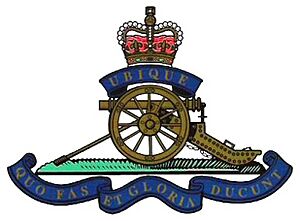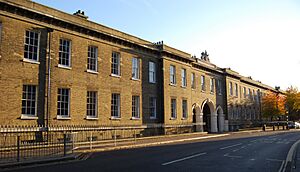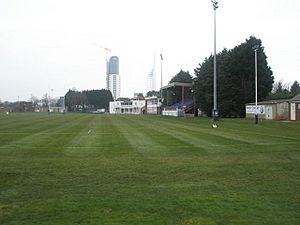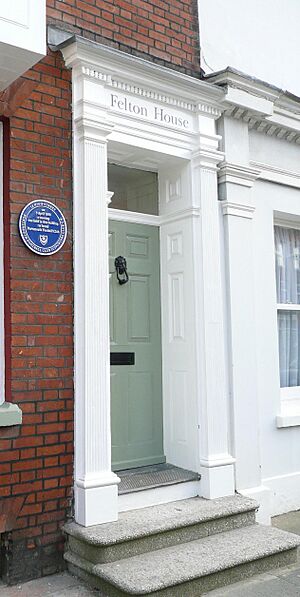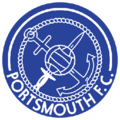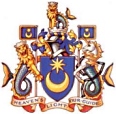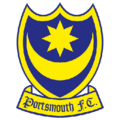History of Portsmouth F.C. facts for kids
Portsmouth Football Club is a professional association football club based in Portsmouth, England. It was first started in 1898. Football was played in Portsmouth even before that, brought by soldiers, sailors, and dock workers from other English towns. These early games helped football become popular in the city. Before Portsmouth F.C. became a professional team, there were several amateur clubs, but none were as successful as the club we know today.
Contents
Early Football Teams in Portsmouth
Before Portsmouth F.C. was formed, there were other football teams in the city.
Portsmouth Association Football Club (1883–1896)
Portsmouth Association Football Club was an amateur team started in 1883. A famous player for this team was Sir Arthur Conan Doyle, who wrote the Sherlock Holmes stories. He played as a goalkeeper under the name "A.C. Smith" while he was working as a doctor in Portsmouth. This team stopped playing in 1896.
Royal Artillery (Portsmouth) Football Club (1894–1899, 1900–1901)
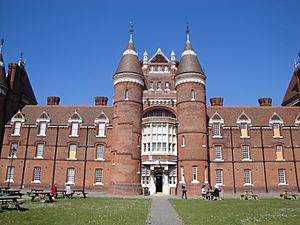
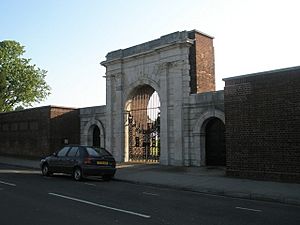
The Royal Artillery (Portsmouth) F.C. was an amateur team made up of soldiers from the Royal Artillery in the British Army. In the 1890s, Portsmouth was an important army town, not just a navy base. Soldiers played sports to stay fit, often at the United Services Recreation Ground.
This team was formed in 1894. They were known as The Gunners because of their army role. They were also nicknamed Pompey, which was a local nickname for the town of Portsmouth. The team played their home games near the Portsmouth Town Hall. The sound of the Town Hall's clock tower bells inspired a supporter's chant called The Town Hall Chimes, which later became The Pompey Chimes.
In 1897, Royal Artillery was promoted to the Southern League's top division. However, in 1899, they were disqualified from the FA Amateur Cup. This happened because the Football Association (FA) decided that the army paying for their training was "professionalism," even though the players themselves weren't paid. This decision caused a lot of debate.
After this, Royal Artillery had to use amateur reserve players and were relegated. Many of their best players left to join professional clubs. The grounds they played on also decided to ban football for a season because it damaged the grass for cricket. The Royal Artillery team officially "retired" in May 1899.
However, the team did reform in 1900 and played for another season, finishing as runners-up in the Hampshire Senior League in 1900–01. They then quietly stopped playing in 1901.
The popularity of the Royal Artillery team helped football grow in Portsmouth. When they stopped playing, many of their fans and even some players switched to a new club that had just been formed.
Portsmouth Football Club is Born (1898)
On 5 April 1898, a new football club was founded. It was originally called the Portsmouth Football and Athletic Company Limited. It was started by a group of local businessmen, led by John Brickwood, who owned a brewery in Portsmouth. They met at a solicitor's office at 12 High Street in Old Portsmouth.
The founders wanted to buy land to build a football ground. They hoped football in Portsmouth would become as popular as it was in northern England, where thousands of fans watched games. They bought agricultural land near the village of Milton. This land would become Fratton Park.
On 15 August 1899, Fratton Park officially opened. Over 1,000 people, including some of the first players, came to see how a former potato field had been turned into a football ground. The name "Fratton Park" was chosen to make people think it was close to Fratton railway station, even though it's actually in the Milton area.
Early Years (1899–1912)
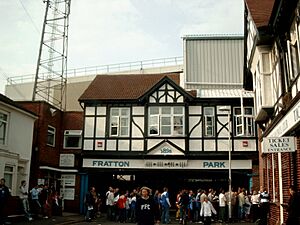
Frank Brettell became Portsmouth Football Club's first manager in February 1899. He signed players from the former Royal Artillery team, like goalkeeper Matt Reilly. He also brought in many talented players from northern clubs like Everton and Liverpool.
Portsmouth made a bold move by applying to join the Southern League First Division right away, without playing in lower divisions first. This was accepted, and they joined for the 1899–1900 season. Their first competitive game was on 2 September 1899, which they won 1–0. Four days later, they played their first home game at Fratton Park, a friendly against rivals Southampton, winning 2–0.
Portsmouth had a very successful first season, finishing as runners-up in the Southern Football League Division One. In their second season (1900–01), they finished third and also won the Western Football League Division One title.
In 1901–02, Portsmouth won the Southern Football League championship title. They also won the Western Football League Division One championship for the second year in a row. They continued to do well in the Western League, winning it again in 1902–03.
In 1905, Richard Bonney, who had helped start the Royal Artillery team, became Portsmouth's third manager. In 1906–07, Portsmouth had a record attendance of 24,329 for an FA Cup game against Manchester United. They drew 2–2 at home and then famously won the replay 2–1 in Manchester.
In 1909–10, Portsmouth changed their team colours to white shirts, navy blue shorts, and navy blue socks. However, the 1910–11 season was tough, and they were relegated. The club also faced serious financial problems.
Portsmouth Football Company Limited (1912–1999)
To fix their money problems, the original company was closed down, and a new one, Portsmouth Football Company Limited, was formed in 1912. This new company had strong financial backing. They also changed their home colours again to blue shirts, white shorts, and black socks.
Portsmouth's famous club crest, with a crescent moon and star, first appeared in the 1913–14 season. This design comes from Portsmouth's town coat of arms and dates back to the time of King Richard I.
Football was stopped during World War I (1914–1918). Many people connected to Portsmouth F.C. joined the army, and many did not return. After the war, in 1919–20, Portsmouth won the Southern League championship for the second time. This success led to them being elected into the Football League Third Division.
Climbing Up the Football League (1920–1927)
Portsmouth started in the new Football League Third Division in 1920–21. They quickly moved up, winning the Third Division South title in 1923–24 and getting promoted to the Football League Second Division.
In 1926–27, Portsmouth finished as runners-up in the Second Division, earning promotion to the top division, the Football League First Division. This was a huge achievement, as they were the first club south of London to reach the First Division and the first to go from the Third Division all the way to the First. During this season, they also had their biggest home win ever, beating Notts County 9–1.
Life at the Top and FA Cup Victory (1927–1939)
Portsmouth struggled a bit in their first season in the First Division (1927–28), but they managed to stay up. In 1928–29, they reached the FA Cup Final for the first time, but lost to Bolton Wanderers.
They reached the FA Cup final again in 1934, but lost to Manchester City. The club used money from player sales and the FA Cup final to rebuild Fratton Park's North Stand, making the stadium much bigger.
In the 1938–39 season, Portsmouth reached the FA Cup Final for the third time. This time, it was third time lucky! They defeated favourites Wolverhampton Wanderers 4–1 to win the FA Cup. This was a huge moment for the club.
The new 1939–40 season began, but football was quickly stopped when World War II started in September 1939.
World War II and Post-War (1939–1948)
During World War II, football continued in regional leagues. Portsmouth, as the FA Cup holders, famously kept the trophy safe during the war. It was moved around Portsmouth to protect it from bombing, even being kept in a country pub in Lovedean. When the war ended in 1945, the FA Cup trophy was proudly shown off at Victory in Europe Day street parties in Portsmouth.
The Football League restarted in 1946–47. Portsmouth had recruited many talented players who were serving in the Royal Navy and Royal Marines during the war. In 1947, Bob Jackson became the new manager. For the 1947–48 season, Portsmouth started wearing red socks. This was suggested by Field Marshal Montgomery, who was the club's honorary President, to remember British servicemen lost in the war.
Glory Years (1948–1959)
In their 50th anniversary season (1948–49), Bob Jackson's Portsmouth team was amazing. They were expected to win both the Football League and the FA Cup. They attracted huge crowds, with a record attendance of 51,385 at Fratton Park for an FA Cup quarter-final. While they lost in the FA Cup semi-final, they won the First Division title, becoming Football League Champions of England!
Portsmouth then won the Football League title again in 1949–50, making them champions for a second year in a row. They are one of only five English teams to have won back-to-back top-flight titles since World War II.
After these glory years, the team gradually changed, and in 1958–59, Portsmouth finished last in the First Division and were relegated to the Second Division, ending their 32-year stay at the top.
Life in the Lower Leagues and Near Oblivion (1959–1979)
Portsmouth continued to struggle and were relegated again to the Third Division in 1960–61. However, under manager George Smith, they won the Third Division title in 1961–62 and were promoted back to the Second Division.
The club faced serious financial trouble in the 1970s. In 1976, they needed to raise £25,000 to avoid bankruptcy, and fans helped raise the money. Despite this, they were relegated to the Third Division in 1976 and then to the Fourth Division in 1978.
Bouncing Back (1979–1988)
Things started to improve when Frank Burrows became manager in 1979. Portsmouth won their first five games in Division Four and were promoted back to the Third Division in 1979–80.
In 1982–83, under manager Bobby Campbell, Portsmouth won the Third Division championship and were promoted back to the Second Division. In 1984, Alan Ball, a 1966 FIFA World Cup winner, became manager. Under him, Portsmouth narrowly missed promotion to the First Division for two seasons in a row.
Finally, in 1986–87, Alan Ball led Portsmouth to a second-place finish in the Second Division, earning promotion back to the First Division for the first time since 1959. However, the club soon faced financial problems again and were relegated back to the Second Division in 1987–88.
Portsmouth City Football Club Limited (1999–2010)
In 1998–99, Portsmouth faced a serious financial crisis and went into administration (meaning they were being managed by experts to sort out their money problems). Luckily, in May 1999, a new chairman, Milan Mandarić, saved the club. He invested a lot of money, and a new company, Portsmouth City Football Club Limited, was created.
Winning the Football League (Second Tier)
In 2002–03, under manager Harry Redknapp, Portsmouth brought in experienced players like Paul Merson and combined them with young talents. They dominated the league, staying at the top for most of the season and winning the Division One championship. This meant they were promoted to the Premier League!
Premier League (2003–2010) and FA Cup Success
Portsmouth surprised many by staying in the Premier League for seven seasons. They had some famous wins, including beating Manchester United at home three times.
In 2004, Harry Redknapp left the club after disagreements, but he returned in late 2005. With new investment from Alexandre Gaydamak and new players, Portsmouth managed to avoid relegation in a dramatic end to the 2005–06 season.
The 2006–07 season was very successful. Portsmouth made a strong start and finished a respectable ninth in the Premier League, their best league finish in over five decades.
The 2007–08 season was even better. Portsmouth won the Asia Trophy in pre-season. On 29 September 2007, they beat Reading 7–4 in the highest-scoring match in Premier League history!
On 8 March 2008, Portsmouth reached the FA Cup semi-finals for the first time in 16 years, beating tournament favourites Manchester United 1–0 at Old Trafford. This earned them a trip to Wembley Stadium. On 5 April 2008, their 110th birthday, they beat West Brom 1–0 in the semi-final.
On 17 May 2008, Portsmouth won the FA Cup by beating Cardiff City 1–0 at Wembley! This was their first major trophy since 1939 and meant they qualified for a European competition (the UEFA Cup) for the first time ever.
Financial Crisis and Relegation (2008–2010)
After their FA Cup win, financial problems began to hit the club again. The owner, Alexandre Gaydamak, looked to sell the club. Key players had to be sold, and new owners came and went, but the money problems continued. Wages were often not paid on time.
In the 2009–10 season, the team struggled at the bottom of the Premier League. Portsmouth were eventually relegated from the Premier League.
Portsmouth Football Club (2010) Limited (2010–2013)
After relegation, Portsmouth played in The Championship (the second tier of English football). The club went into administration again, facing the risk of being closed down. However, a new owner, Vladamir Antonov, saved the club, and a new company, Portsmouth Football Club (2010) Limited, was formed.
Relegations to League One and Two
Despite the rescue, financial problems continued. The club had to sell many players. In 2012, Portsmouth were relegated to League One. More financial issues meant they were relegated again to League Two at the end of the 2012–13 season. The Football League also deducted 10 points for going into administration, even though they were already relegated.
Portsmouth Community Football Club Limited (2013–present)
On 10 April 2013, the Pompey Supporters Trust (PST), a group of fans, became the new owners of the club. This was a historic moment, as it meant the fans now owned their club. The new parent company was named Portsmouth Community Football Club Limited.
The club struggled in League Two at first, but in 2014, Andy Awford took over as caretaker manager and led the team to safety. In 2015, Paul Cook became the new manager.
Paul Cook led Portsmouth to the play-offs in 2015–16, but they lost in the semi-final. In 2016–17, his team secured promotion to League One and then won the League Two title on the final day of the season!
In 2017, the fans voted to sell the club to The Tornante Company, led by former Disney chief executive Michael Eisner. Kenny Jackett became the new manager.
EFL League One (2017 to Present)
In 2018, the club revealed a new crest with a nautical compass star and the "1898" founding year.
On 31 March 2019, Portsmouth won the 2019 EFL Trophy final at Wembley Stadium, beating Sunderland on penalties after a thrilling 2–2 draw. They also reached the League One play-offs but lost to Sunderland.
In 2019–20, Portsmouth had a club record of nine consecutive wins. They reached the 2020 EFL Trophy final again, but due to the COVID-19 coronavirus pandemic, the season was cut short. Portsmouth finished fifth and reached the play-offs, but lost on penalties. The delayed 2019–20 EFL Trophy final was played in March 2021, but Portsmouth lost on penalties to Salford City.
After a period of mixed results, John Mousinho was appointed head coach in January 2023. In the 2023–24 season, Portsmouth started strongly and were promoted as champions, ending their 12-year stay outside the top two divisions of English football.
Images for kids
-
The former Clarence Barracks, now used as Portsmouth City Museum.
-
The main gates to the United Services Recreation Ground in Burnaby Road, Portsmouth.
-
Portsmouth have played at Fratton Park since their foundation in 1898
-
Nwankwo Kanu signed for Portsmouth for free before the 2006–07 season and ended the season as the club's top scorer
-
Portsmouth playing Milan in the UEFA Cup, with players including Nwankwo Kanu, Peter Crouch and Younès Kaboul


